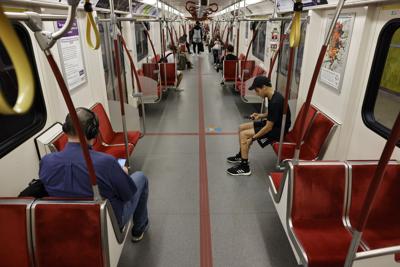The big number
51.6 million
the expected annual ridership boost if the TTC were to adopt a fare system where passengers ride free after making 32 trips in a month.
New TTC CEO Mandeep Lali’s biggest challenge is easy to sum up: he needs to convince a heck of a lot more of us to take transit.
Mandeep Lali, who has worked at New York’s MTA and London’s Transport for London, calls himself “a people-first oriented leader.”
Mandeep Lali, who has worked at New York’s MTA and London’s Transport for London, calls himself “a people-first oriented leader.”
At $2.6 billion this year, the transit agency’s budget is bigger than ever, with total spending on conventional service up 37 per cent this year on the pre-pandemic spending level from 2019. And pandemic recovery seems to have stalled, . But there’s some good news for the new guy: a suggests there just might be an easy way for Lali to boost these ridership numbers.
It’s called fare capping. To understand it, you first have to understand this: the monthly pass currently offered by the TTC is one of the worst deals in town.
At a whopping $156 monthly, the standard unlimited-ride pass only makes financial sense if you take 48 trips per month. With fares set at $3.30 per trip, that’s the break-even point for the pass holder. If you’re only using the TTC for commuting, you’re unlikely to reach that threshold every month. Take a couple of sick days, surprise work-from-home days, or fun days playing hooky, and you might find yourself giving the TTC money for nothing.
The Waterfront East LRT is expected to service more than 100,000 people, but there’s one catch — there’s no money to actually build it.
And because the current monthly pass needs to be purchased at the beginning of the month, there’s no flexibility. Riders instead need to use their crystal ball to guess whether they’ll benefit from the pass. It’s a monthly gamble, and given the too-high cost of the pass and the too-low wages of a lot of riders, it’s not low stakes.
A fare capping program would get rid of the gambling. Instead of having to buy a pass in advance, the TTC would instead set a monthly threshold after which every additional ride you take is free.
Analysis presented to the most recent meeting of the TTC’s Strategic Planning Committee concludes this kind of system could significantly increase ridership. An initiative that lets passengers ride free after 40 monthly rides would boost annual ridership by 16.8 million people. And a more beneficial cap that kicks in after 32 rides would cause a real transit boom, adding 51.6 million rides annually.
To put those numbers into context, 2025 ridership is expected to be about 87 million below 2019 levels. That means that more than half the pandemic ridership loss could be recovered by a relatively simple fare change.
It’s not hard to understand the appeal of a fare capping program. It would serve as a financial reward for the TTC’s most frequent riders. And it would incentivize more TTC trips. Once taking the subway is effectively free, why not use it for some of those weekend trips out instead of calling an Uber?
Accumulated data shows that where contested projects for É«É«À² streets have been allowed to go forward, the result has been basically fine.
Accumulated data shows that where contested projects for É«É«À² streets have been allowed to go forward, the result has been basically fine.
The downside is that fare capping does come at a cost. The TTC’s analysis says the 40-ride cap would reduce its revenue from fares by $35 million, as people who currently buy the expensive pre-paid monthly pass instead save money by fare capping. Similarly, the 32-ride cap would result in $100 million in foregone revenue, as frequent TTC riders would suddenly find themselves saving a lot of money each month.
But there are ways to balance things out. A small 10-cent increase to the single-ride fare, which has been frozen at $3.30 since 2023, would generate $33 million, nearly balancing out the impact of the 40-ride cap. A more significant 35-cent increase to the base fare would raise nearly $93 million, nearly offsetting the cost of a 32-ride cap.
These are the kinds of trade-offs that Mayor Olivia Chow needs to be prepared to talk about. Increasing the cost for infrequent riders while reducing costs for everyday transit users feels like a reasonable trade.
Of course, with an infusion of provincial money to fund TTC operations, talk of any kind of major fare increase could be taken off the table altogether. Hint hint, Premier Doug Ford.
Absent that, the ideal balance is a matter for debate. The TTC board is set to consider a new ridership growth strategy this December, which could include a recommendation for a fare capping scheme. It’s long overdue — the TTC Board endorsed fare capping as a policy way back in 2022, but nothing has changed since.
É«É«À² Star transportation reporter Andy Takagi sits down with the new TTC CEO, Mandeep Lali.
For new TTC boss Mandeep Lali, the benefit of the higher ridership brought by fare capping is that it would help justify adding more service, which could in turn help grow ridership even further.
It could pay dividends in other ways, too. Another striking stat that emerged at the TTC committee meeting last week was that ridership these days is about equivalent to ridership in 1991, when É«É«À²â€™s population was more than half a million people smaller than it is today.
If fare capping can help build per-capita ridership levels back up to near the same levels this city saw 34 years ago, that could take thousands of cars off the road. I’d tip my cap to that.
Error! Sorry, there was an error processing your request.
There was a problem with the recaptcha. Please try again.
You may unsubscribe at any time. By signing up, you agree to our and . This site is protected by reCAPTCHA and the Google and apply.
Want more of the latest from us? Sign up for more at our newsletter page.






























To join the conversation set a first and last name in your user profile.
Sign in or register for free to join the Conversation